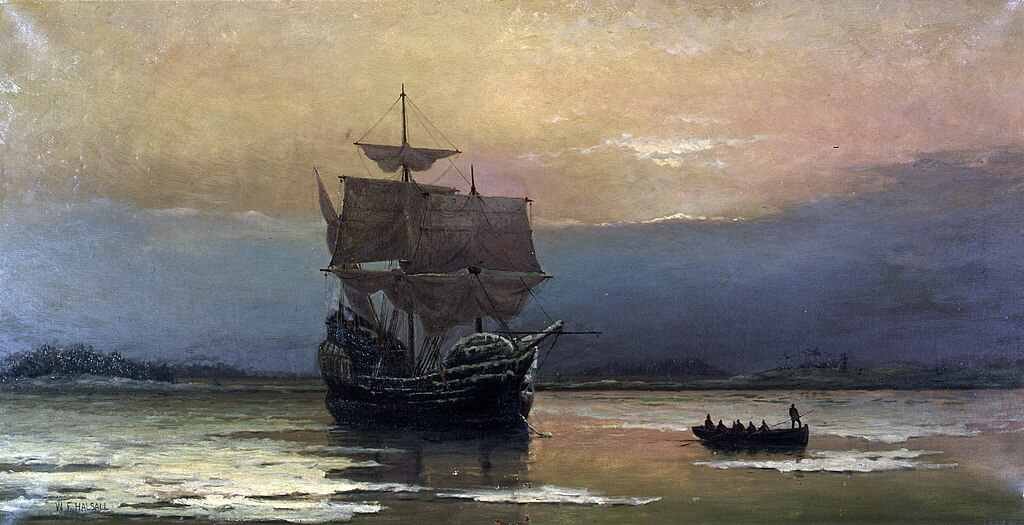Mayflower Ship (1620)
The Mayflower ship is an English merchant ship that became famous for transporting a group of religious dissidents, the Pilgrim fathers, from England to North America in 1620, in search of a place to practice their religion freely.
A vessel, the Mayflower, departing from Plymouth in England, arrived in North America in 1620 with a hundred passengers, including English Puritans, later called Pilgrim Fathers. After a difficult start, the colony prospered. A holiday, Thanksgiving, commemorates this settlement in the United States, which has a considerable influence on American culture.
The passengers of the Mayflower are also at the origin of the feast of Thanksgiving (United States), celebrated in memory of the three days of thanksgiving that Governor William Bradford decreed in the fall of 1621 to celebrate the first harvest of the colonists.
An eventful journey
In July 1620, some English Puritans, wanting to be able to practice their religion freely, left to emigrate to North America. Two vessels are armed: one departing from the Thames in England, the Mayflower with 65 passengers on board, the other coming from Holland, the Speedwell with Puritan passengers, refugees in the Netherlands, most of them English belonging to the Leiden community. The meeting is set off Southampton for a departure in early August. Damage to the Speedwell requires repair at Dartmouth. After a new start, a new damage occurs on the Speedwell 200 miles from the coast. The two boats reach Plymouth where they have to abandon the Speedwell. Some of the passengers of this boat embark on the Mayflower, while the others return to Holland.
Only the Mayflower sailed from Plymouth on September 6, 1620, with the intention of reaching Virginia where there had already been an English settlement since 1607. It is a three-masted ship of 180 tons, 27 meters long, equipped with cannons, with 102 passengers on board – men, women and children – including about 35 Puritans, plus a crew of about thirty men. .
During the crossing, the boat was caught by the storm and, on November 9, reached Cape Cod, in the present state of Massachusetts in New England. Bad weather having frustrated an attempt to reach Virginia, the Mayflower finally returned to anchor on November 11, 1620, in Cape Cod Bay.
The beginning of the colony
Before disembarking, the male passengers held a council and 41 of them signed a pact which fixed the statutes of the future colony: the Mayflower Compact (pact). In this document, the signatories pledge allegiance to King James I of England and agree before God and before each of them to constitute themselves into a civil body politic, to devise just and equitable laws for the good of the colony, to which they promise to submit.
During the winter of 1620-1621, the passengers remained on board, but illness, harsh weather and lack of food caused the death of nearly half of the colony. The crew is also affected. In March 1621, the passengers disembarked and took up residence in huts while organizing their defense against a possible attack by the natives, under the direction of Captain Myles Standish (c. 1584-1656) with the assistance of Christopher Jones, Captain of the Mayflower . In April, he brought the Mayflower back to England with the survivors of the crew.
Fortunately for the settlers, the Iroquois Indians were peaceful and taught them how to grow corn and fish.
The first elected governor, John Carver (1576-1621), was a businessman who helped organize the expedition.
The second governor, William Bradford (1590-1657), elected in 1621 and then always re-elected until 1644, comes from the Netherlands. He is the author of a chronicle of the first thirty years of the colony. In the fall of 1621, he organized a feast – Thanksgiving – on the anniversary of their arrival, to thank God and the Indians for having been able to obtain their first harvest. He institutes a day of rest for the colony.
The settlers gave their settlement the name of New Plymouth, which would become Plymouth, named after the English port of departure.
Read also: Native American Heritage : culture, ritual and ceremony, belief, custom and symbol
A founding episode for the United States
The colony created by the passengers of the Mayflower is not the first established on the east coast of North America. But it is considered a founding episode of the American nation because, more than the others, it was the bearer of an ideal of freedom.
The biblical influence of the Puritans strongly permeated American culture: they compared the crossing of the Atlantic to that of the Red Sea by the Hebrews and their settlement to that of the Hebrews in Palestine.
Thus it was the Massachusetts Bay Colony that founded Harvard University in 1636 which, at its beginning, was under the influence of Puritanism and trained many pastors.
The Compact inspired the United States Constitution. President George Washington (1732-1799) chose Thanksgiving to celebrate the ratification of the Constitution and, in 1863, President Abraham Lincoln (1809-1865) fixed his celebration on the 4th Thursday of November. Thanksgiving has been a holiday since 1941.
It has become a secular celebration: families gather around a hearty meal traditionally including boiled corn on the cob or potatoes and turkey.
Thanksgiving is also celebrated in Canada on the second Monday in October as a harvest festival.
The Puritans of the Mayflower are called pilgrims (Pilgrims) in 1793, then pilgrim fathers (Pilgrim Fathers) since 1820. The descent of the passengers, considered as a true aristocracy, is numerous; it includes eight presidents of the United States.
The Mayflower and the Thanksgiving Myth
The following spring, in 1621, the Iroquois Indians taught the settlers how to grow corn, as well as hunting and fishing in these unknown lands. Following their first harvest, the settlers decide to thank God and the Indians. The latter were already celebrating “Thanksgiving” in the fall, after the harvest. The pilgrims take up this idea: each year, they celebrate the autumn harvest during “Thanksgiving Day”.
It was in 1863 that President Abraham Lincoln erected this date as a national holiday. The pilgrims of the “Mayflower” are considered the first founding settlers of the future United States of America.
Conclusion
However, the Pilgrims survived and would celebrate their arrival in the New World and all the Native Americans had done for them with a party on the first anniversary of their arrival in the fall of 1621. Captain Jones was long gone for England at that time, and the Pilgrims had themselves built houses and established crops to keep them alive through the following winter. This first holiday, mentioned by Bradford and Winslow, would later be institutionalized as the national holiday of Thanksgiving in the United States by President Abraham Lincoln (in office 1861-1865).
Captain Christopher Jones died in 1622 after returning from one of his trading voyages to France, and the Mayflower then lay at anchor in Rotherhithe-on-Thames harbor for two years during which time it was left to rot. In 1624 she was sold as scrap for about 130 pounds, a sum divided between the owners and Jones’ widow. According to traditional accounts, parts of the ship were used to build the Mayflower Barn at Jordans in Buckinghamshire, England, but this claim has been disputed on several occasions. Whatever the Mayflower’s final fate, their name remains that of the iconic vessel that brought Pilgrims to the New World to establish their vision of a land of promise where people could live and pray freely.
Sources: PinterPandai, History, Britannica, Historic UK
Photo credit: Photograph: Artcom and Pilgrim Hall Museum (Domaine public)
Photo description: painting Mayflower in Plymouth Harbor, by William Halsall, 1882 at Pilgrim Hall Museum, Plymouth, Massachusetts, USA.



